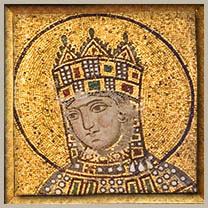Learn more about Pallasart Web Design's Creative Talent - Meet Our Team of Programmers and Designers

The tchinovniks' house, the workmen's houses', the barracks for the soldiers and the shops, were standing by the side of the lake, where the classical gymnasium and the town hall now stand.
The principal building of the banknote manufactory is now occupied by the industrial school; part of the land, on the right side of the lake, is now a park, belonging to the Countess Hohenfelsen, who bought it from the Secretary of State Polovtzov. The Imperial Nicholaevsky classical gymnasium was founded in 1870 in memory of the Emperor Nicholas I and the Tsarevich Nicholas Alexandrovich. It consists of one preparatory and eight main classes. It is kept up by the Ministry of Public Instruction, by the town, by the merchants and by the house owners. The tuition fee is 70 rubles a year. The Gymnasium has its own church, which was built by the architect Vidov, and was consecrated on the 8th of September 1872. The church has an altar, which belonged to Catherine I. The gymnasium occupies a stone house belonging to the town, which was originally built for the Nicholaevsky town-library on the ground, given by His Majesty to the Town Hall together with the buildings of the old banknote manufactory. The Architect Monighetti presented for the Imperial approval in 1862 plans for the building of an alms house in Memory of the Emperor Nicholas I and on the 23d of Nov. 1863 its regulations were confirmed. The first paragraph of them states, that the almshouse was founded in memory of the Emperor Nicholas I, and of the Grand Duke Nicholas Alexandrovich. The building was commenced; but in 1869 it happened, that the town had no sufficient means to finish it and to support the almshouse; the Town Hall solicited the right of passing over the building to the classic gymnasium which was being founded. The Emperor Alexander II acceded to this solicitation and ordered the Nicholaevskaya almshouse for 10 men and 10 women to be transferred into the building of the Court Hospital. In 1889 a third story was added to the building by the civil engineer Smirnov for the accommodation of boarders; at the present time however boarders are not taken. By the side of the gymnasium stands the Town Hall, which was altered in 1862-65 by the architect Monighetti from the old buildings formerly occupied by workmen, belonging to the banknote manufactory. Up to that time the Town Hall occupied a house on the Moskovskaya street, on the spot of the Russian Trade and Commercial Bank. In 1902 the architect Bach constructed a special staircase, leading to a gorgeously decorated hall, which is used on all kinds of ceremonial occasions, for sessions of the district court and for military purposes, as well as for theatrical performances and concerts. Its walls are hung with the portraits of the Emperor Alexander II, Alexander III, and Nicholas II. There are bronze busts besides of the Empress Catherine I and Catherine II and the Emperor Alexander I, and in the antechamber a bust of the General-of-Artillery Jakov Vasilievich Zacharjevsky, who for 48 years was commander in chief of Tsarskoe Selo. By the side of the town hall, there still exists in its one-storied original form a low building, the former house of the workmen from the banknote manufactory. It is now occupied by the Town Hall watchman. Facing the dam, stands a three-storied stone building of the girl's industrial school, under the patronage of H.I.M. the Empress Maria Feodorovna. As it has already been stated, this building was formerly the main block of the banknote manufactory. In 1872 the building and 1755sq. sadjens of land were bought for the industrial school, at a cost of 10,000 rubles. In 1878 another piece of Court land was added to this, while the building was reconstructed for the establishment and boarding school. The school was founded in 1872. Its regulations were confirmed on the 2th of April 1876. It belongs to the number of philanthropic institutions and takes care of orphans and poor children of all conditions, to whom it gives a moral and religious education. The girls are taught hand work, cooking, sewing and washing. The Asylum takes children between the ages of 8 and 11. The course of instruction is the same, as at the town elementary school. The number of pupils is about 80. The fees are 100 rubles a year and 25 on entering. The school is entertained by the following means, the fees from the pupils, the hand-work, made at the school, the money paid to the school choir, when it sings at different churches, gifts from philanthropists and also the proceeds from bazaars, lotteries and such like. The school has four scholarships of 75 rubles each from H.I.M. the Empress Maria Feodorovna; twenty of 75 rubles from the St. Petersburg Town Hall; and two of 75 rubles from the Tsarskoe Selo Town Hall. In ancient times i. e. at the end of the XVII and the beginning of the XVIII centuries, when the Sarskaya farm was only a village with, a landowners house, there used to stand along, what is now the Sadovaya, a row of buildings, a poultry yard, horse and cattle yards, warehouses and four granaries. Actually the court stables, glass-houses, a manege four knights' houses and the wing of the Lyceum are facing the Sadovaya; the Lutheran church, the gymnasium, and the Town Hall, face the Naberejnaya. When Catherine Alexeevna came into the possession of the Sarskaya farm, there grew up quite a settlement of buildings, which covered also the two parallel streets the present Srednaya and Malaya. The settlement continued to grow on this spade until 1808, when the wall, which surrounded this suburb, was pulled down, and the town was extended to the boulevards. The old park, from the palace to the Rybny-canal, in the time of the Tsarevna Elizabeth Petrovna was separated from the settlement by a wooden palisade, which stood on the place of the actual canal, stretching from the "swan" to the pond of the Lower Park. On the 18th of May 1750 this palisade was removed, and a stone wall with five gates built in its place. This wall existed till 1774, when the Empress Catherine ordered it to be taken down and replaced by a canal with dams and a bridge. The granite pavement with its iron fence and granite pillars was then continued along the street. |









